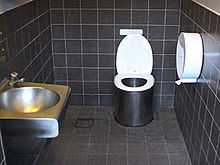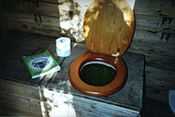Composting toilet

A composting toilet is a dry toilet that uses a predominantly aerobic processing system that treats excreta, typically with no water or small volumes of flush water, via composting or managed aerobic decomposition.[1] Composting toilets may be used as an alternative to flush toilets in situations where there is no suitable water supply or waste treatment facility available or to capture nutrients in human excreta as humanure. They are in use in many of the roadside facilities in Sweden and in national parks in both the United States and the United Kingdom.[citation needed]
The human excrement is normally mixed with sawdust, coconut coir or peat moss to support aerobic processing, absorb liquids, and to reduce the odor. The decomposition process is generally faster than the anaerobic decomposition used in wet sewage treatment systems such as septic tanks.
Operating process

Although there are many designs, the process factors at work are the same. Rapid aerobic composting will be thermophilic decomposition in which bacteria that thrive at high temperatures (40-60 °C or 104-140 °F) oxidize (break down) the waste into its components, some of which are consumed in the process, reducing volume, and eliminating potential pathogens.
Drainage of excess liquid or leachate via a separate drain at the bottom of the composter is featured in some manufactured units, as the aerobic composting process requires moisture levels to be controlled (ideally 50±10%): too dry, and the mass decomposes slowly or not at all; too wet and anaerobic organisms thrive, creating undesirable odors (cf. Anaerobic digestion). This separated liquid may be diverted to a blackwater system or collected for other uses. Some units include a urine-separator or urine-diverting system.
Where solar heat is used, this might be called a "solar" toilet.[2] These systems depend on desiccation to achieve sanitation safety goals[3] features systems that make use of the separated liquid fraction for immediate area fertilization.
Urine can contain up to 90 percent of the nitrogen, up to 50 percent of the phosphorus, and up to 70 percent of the potassium present in human excreta.[4] In healthy individuals it is usually pathogen free, although undiluted it may contain inorganic salts and organic compounds at levels toxic to plants.[5]
The other requirement critical for microbial action (as well as drying) is oxygen. Commercial systems provide methods of ventilation that move air from the room, through the waste container, and out a vertical pipe, venting above the enclosure roof. This air movement (via convection or fan forced) will vent carbon dioxide and odors.
Some units require manual methods for periodic aeration of the solid mass such as rotating a drum inside the unit or working an "aerator rake" through the mass. Composting toilet brands have different provisions for emptying the "finished product," and supply a range of capacities based on volume of use. Frequency of emptying will depend on the speed of the decomposition process and capacity, from a few months (active hot composting) to years (passive, cold composting). With a properly sized and managed unit, a very small volume (about 10% of inputs) of a humus-like material results, which can be suitable as soil amendment for agriculture, depending on local public health regulations.
Composting toilets greatly reduce the volume of excreta on site through psychrophilic, thermophilic or mesophilic composting and yield a soil amendment that can be used in horticultural or agricultural applications as local regulations allow. In combination with a constructed wetland these even require only the half area.[6]
These should not be confused with the pit latrine, arborloo or tree bog all of which are forms of less controlled decomposition, and may not protect ground water from nutrient or pathogen contamination or provide optimal nutrient recycling.
Types
Manufactured composting toilet systems
Several manufactured composting toilet models are on the market, and construct-it-yourself systems are also popular.[7]
"Self-contained" composting toilets complete or begin the composting in a container within the receiving fixture. They are slightly larger than a flush toilet, but use roughly the same floor space. Some units use fans for aeration, and optionally, heating elements to maintain optimum temperatures to hasten the composting process and to evaporate urine and other moisture. Operators of composting toilets commonly add a small amount of absorbent carbon material (such as untreated sawdust, coconut coir, peat moss) after each use to create air pockets for better aerobic processing, to absorb liquid, and to create an odor barrier. This additive is sometimes referred to as "bulking agent." Some owner-operators use microbial "starter" cultures to ensure composting bacteria are in the process, although this is not critical.
"Remote," "central," or "underfloor" units collect excreta via a toilet stool, either waterless or micro-flush, from which it drains to a composter. "Vacuum-flush systems" can flush horizontally or upward with a small amount of water to the composter; "micro-flush toilets" use about 500 millilitres (17 US fl oz) per use. These units feature a chamber below the toilet stool (such as in a basement or outside) where composting takes place and are suitable for high-volume and year-round applications as well as to serve multiple toilet stools.
"Desiccating toilets" dry the excreta to destroy pathogens, though one study suggested that drying can result in rehydration of pathogens when in contact with moisture later.[8]
Self built unit
Site-built or self-built composting toilet designs vary, ranging from rollaway containers fitted with aerators to large concrete sloped-bottom tanks.
Regulation
There are no universally accepted performance standards for composting toilets in the United States, although seven jurisdictions in North America[9] rely on testing of manufactured systems to American National Standard/NSF International Standard ANSI/NSF 41-1998: Non-Liquid Saturated Treatment Systems.[10] An updated version of ANSI/NSF Standard 41 was published in 2011.[11][note 1] Systems might also be listed with CSA, cETL-US, and other standards programs.
Gallery
-

This is the pedestal for a split-system composting toilet where collection/treatment chambers are located below the bathroom floor. The pedestal is 100% waterless and is easier to clean than a flushing toilet pedestal.
-
Henry Moule's earth closet, patented in 1873. Example from around 1875. Rear chamber for dispensing cover material
-
Composting toilet in wood
See also
Notes
- ↑ A listing of the most current NSF/ANSI standards can be found in PDF format at NSF International's Standards subdomain.
References
- ↑ US EPA "Fact Sheet: Composting Toilets"
- ↑ Dry Composting Toilet Demonstration Project
- ↑ A study of single-vault composting systems "Survival of Fecal Coliforms in Dry-Composting Toilets"
- ↑ J.O. Drangert, Urine separation systems
- ↑ Liquid Gold: The Lore & Logic of Using Urine to Grow Plants, 2004
- ↑ Waterreport: Composting toilets and constructed wetlands
- ↑ National Small Flows Clearinghouse, West Virginia University, Composting toilet technology
- ↑ Austin, Aussie (October 2000). "Health implications of reusing dehydrated faecal matter". Deutsche Gesellschaft für Technische Zusammenarbeit. Retrieved 2009-06-05.
- ↑ Oregon Onsite Advisory Committee "Final Report of Recommended Changes to Rules Governing Onsite Systems", OR DEQ, February 8, 2010, accessed May 8, 2011.
- ↑ EPA on ANSI/NSF standard
- ↑ "PUBLICATIONS - Standards and Criteria - March 21, 2013" (PDF). NSF International. p. 4. Retrieved 24 March 2013. "Wastewater Treatment Units … NSF/ANSI 41 – 2011: Non-liquid saturated treatment systems (composting toilets)"
External links
| |||||||||||||||||||||||
| ||||||||||||||||
| |||||||||||




